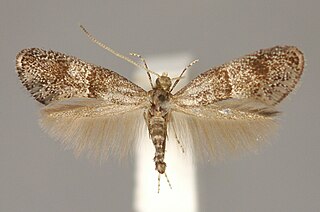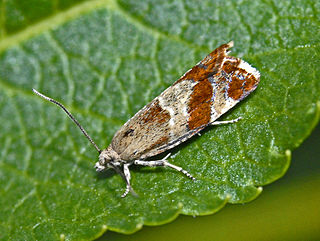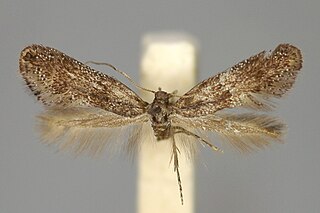
The oriental pratincole, also known as the grasshopper-bird or swallow-plover, is a wader in the pratincole family, Glareolidae.

Notodontidae is a family of moths with approximately 3,800 known species. The family was described by James Francis Stephens in 1829. Moths of this family are found in all parts of the world, but they are most concentrated in tropical areas, especially in the New World.

The soldier flies are a family of flies. The family contains over 2,700 species in over 380 extant genera worldwide. Larvae are found in a wide array of locations, mostly in wetlands, damp places in soil, sod, under bark, in animal excrement, and in decaying organic matter. Adults are found near larval habitats. They are diverse in size and shape, though they commonly are partly or wholly metallic green, or somewhat wasplike mimics, marked with black and yellow or green and sometimes metallic. They are often rather inactive flies which typically rest with their wings placed one above the other over the abdomen.

A leaf miner is any one of numerous species of insects in which the larval stage lives in, and eats, the leaf tissue of plants. The vast majority of leaf-mining insects are moths (Lepidoptera), sawflies, and flies (Diptera). Some beetles also exhibit this behavior.

Douglasiidae is a small Lepidopteran family including around 28 species of micromoth whose adults are collectively called Douglas moths. The largest genus in the family is Tinagma. They are primarily found in the Palearctic and Nearctic realms. The adults have a 6 to 15 mm wingspan, with a reduced hindwing venation and long fringes. The larvae are leaf miners or borers, primarily in stems and petioles, belonging to Boraginaceae, Labiatae, and Rosaceae.

The dryandra moth is a species of moth that is considered to be the sole member of the family Carthaeidae. Its closest relatives are the Saturniidae and it bears a resemblance to many species of that family, bearing prominent eyespots on all wings. The common name is derived from the Dryandra shrubs of the genus Banksia, on which the larva of this species feed, and is hence restricted to the south-west of Western Australia where these shrubs grow. Other Grevillea shrubs may also be used as host plants.

Epinotia cruciana, the willow tortrix, is a moth of the family Tortricidae.

Gypsonoma minutana, the poplar tortricid, is a moth of the family Tortricidae. It is found in Europe and North Africa, Turkey, Transcaucasia, Ural, Kazakhstan, from central Asia to Siberia and eastern Russia, Asia Minor, Iran, Afghanistan, Mongolia, China and Japan.
Tinagma dryadis is a moth of the family Douglasiidae. It was described by Staudinger in 1872. It is found in Scandinavia, northern Russia, France, Switzerland, Austria and Italy.

Tinagma balteolella is a moth in the Douglasiidae family. It is found in Great Britain, France, Belgium, the Netherlands, Germany, Switzerland, Austria, Italy, Spain, the Czech Republic, Slovakia, Croatia, Hungary, Romania, Poland, Lithuania and Ukraine. It is also found in Morocco and Jordan.

Tinagma perdicella is a moth in the family Douglasiidae. It is found in the Netherlands, Belgium, France, Germany, Switzerland, Austria, Italy, Spain, Poland, Albania, Serbia, Croatia, the Czech Republic, Slovakia, North Macedonia, Romania, Norway, Sweden, Finland, the Baltic region, Belarus, Ukraine and Russia.

Tinagma signatum is a moth in the Douglasiidae family. It is found in the Austria, the Czech Republic, Slovakia, Germany, Italy and Russia.

Tinagma is a genus of moths in the Douglasiidae family. It is primarily found in the Palearctic and Nearctic realms

Tinagma anchusella is a moth in the Douglasiidae family. It is found in Denmark, Germany, Austria, Poland, Bulgaria, Greece, Estonia, Latvia, Sweden, Ukraine and on Cyprus. It is also found in Turkey, Jordan and the Caucasus region.
Tinagma klimeschi is a moth in the family Douglasiidae. It is found in Israel, Egypt and on Rhodes and Cyprus.
Tinagma giganteum is a moth in the Douglasiidae family. It is found in North America, where it has been recorded from Alberta and Montana. The habitat consists of dry meadows.
Tinagma pulverilinea is a moth in the Douglasiidae family. It is found in North America, where it has been recorded from Alberta, Montana and California.
Tinagma ochremaculella is a moth in the family Douglasiidae. It is found in North America, where it has been recorded from Texas.
Tinagma obscurofasciella is a moth in the family Douglasiidae. It is found in North America, where it has been recorded from Kentucky, Maine, Michigan and Minnesota.
Tinagma gaedikei is a moth in the Douglasiidae family. It is found in North America, where it has been recorded from central Illinois and northern Kentucky.











